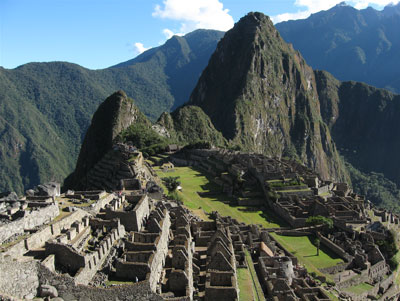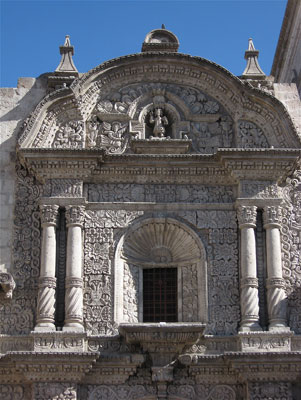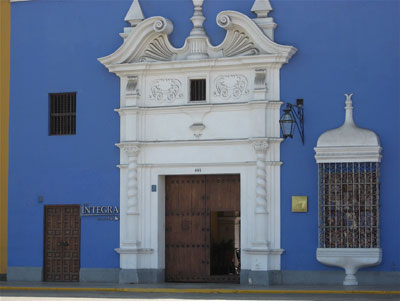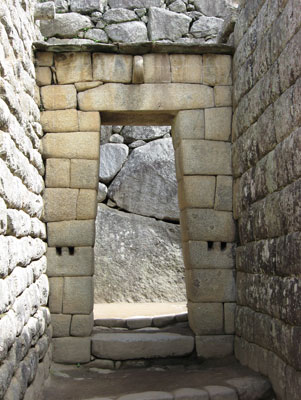Peru — Exploring Machu Picchu and beyond
by Paul Burke, Harpers Ferry, WV. Photos by JoAnn Koppany, San Diego, CA
Machu Picchu has a beautiful setting. While the ruins themselves are simple rock walls, you can look both up and down at precipitous granite mountains and forests. However, if you want sculpture or carvings, this is not the place; it has nothing like the extensive carvings found in Mexico, Asia and the Mediterranean.
Revisiting the site
It had been 30 years since I last visited Machu Picchu, and on this July-August ’08 trip I found it had grown a lot. Staff said that about 40% of what visitors see today is restoration, indicated by a slightly different color in the mud mortar that holds the walls together. The farm terraces are mostly original, and there the mud mortar is deeply recessed in the spaces between the rocks, as would be expected after 500 years.
My father visited about 70 years ago, riding horses up to the site, and he says there was, then, little to see. Horses are no longer needed, and access is comfortable.
Wright and Zegarra’s “The Machu Picchu Guidebook” is a great guide, but even in the few years since it was published (2004), some passages at the site have been closed off with new walls.
We minimized the risk of altitude sickness after flying up from Lima by immediately taking a taxi from the Cusco airport (11,000 feet) to Ollantaytambo (9,000 feet), halfway to Machu Picchu. We had lunch there and took a train the same afternoon to Machu Picchu Town (7,000 feet), formerly called Aguas Calientes. Thus we spent the day at high altitude but not the night. Spending the whole first night at high elevation seems to be the culprit in altitude sickness.
Exploring the area
We spent four full days in Machu Picchu, two looking at nature and two at the archaeological site.
Many people say the $40-per-day admission cost is too high to spend an extra day at the site (the cost is half as much for Peruvians and students), but we were glad we did. When people spend thousands to get there, why quibble over $40 more? Disneyland costs $70 a day; a Broadway play, the Royal Opera in London or a 2-person show at the Sydney Opera House costs over $100 and often much more. With people calling Machu Picchu a wonder of the world or a once-in-a-lifetime experience, I think it’s appropriate to pay a substantial price to help support it.
The area around Machu Picchu Town is filled with orchids, bromeliads, ferns, palms, vines and a dramatic river, the Urubamba, rushing over rocks. We found no tour guide who specialized in nature, so we walked around on our own and had a great time, going out of town in both directions.
There is a well-labeled botanic garden at the museum downstream and a rumor of an ecological center farther downstream along the train tracks. We did find an ecological center upstream at the Machu Picchu Pueblo Hotel (www.inkaterra.com). It is open to hotel guests (rooms start at $450), but if you have a 30-dollar meal there they might let you walk through their reserve.
If we’d had more time, we could have taken the daily train 15 miles farther downstream to the hydroelectric plant from where minibuses travel down to the rainforest a day away at Quillabamba.
Elsewhere in Peru, highlights included the spectacular scenery seen on our luxurious intercity bus trips (phone +311 5050, www.cruzdelsur.com.pe). I believe more people would travel this way if the tour books and the bus website had photos and descriptions of the scenery.
From Cusco to Arequipa we passed first through the high valley, with numerous flocks of alpacas, llamas and sheep. After Juliaca the road climbed even higher, over spectacular hills and passes and past rivers, a lake and a couple of small herds of wild vicuña. This 10-hour bus trip cost $34 per person.
From Arequipa to Ica ($46) and Lima to Trujillo ($39), the bus routes crossed desert, often in sight of the Pacific surf. We were there in August, when the coast was overcast, but we still had great visibility.
Noteworthy sights
Some of the interesting archaeological sites we visited were the Moon Temple outside Trujillo, where frescoed walls were buried by temple expansion, resulting in layers that, when excavated by archaeologists, are as fresh as when they were painted, and Áspero and Caral, outside Supe, where the oldest cities in the Americas, some of the oldest in the world, are being excavated.
The zoo in Lima includes major temples and an on-site museum as well as good exhibits of Peruvian animals.
Colonial homes in Arequipa and Trujillo showed both simplicity, compared to modern luxury homes, and grandeur, compared to how most lived.
Displays of ancient textiles were closed at both major public Lima museums (Nación and Arqueología), so we stopped at the Regional Museum of Ica (Jr. Ayabaca, Block 8 s/n), which has another major collection. They had a few textiles on display, appropriately kept under dim light to preserve them, but the rest of the room was so bright that my eyes could not adapt to appreciate the textiles.
I also was very aware that the textiles were taken from graves where people were laid to rest with the objects they needed for eternity. Since no traveler returns from that journey, no one knows if their beliefs are right; maybe they do need these possessions with them. Like many others, I’d prefer that the bodies and the objects buried with them be protected in place, displaying instead high-resolution photos or replicas.
Making arrangements
We depended mostly on Lonely Planet’s “Peru” (which is full of phone numbers and e-mail addresses) and andeantravelweb.com.
In Arequipa, we enjoyed the hostal Tronco de Oro (phone +57 54 275 959, www.hostaltroncodeoro.com), at $35 a night. It was interesting to stay in a middle-class area of the city.
At Hostal Continental (Av. Imperio de los Incas 127; phone +51 84 211325 or e-mail reservas@siahotels.com) in Machu Picchu Town, we had an end room with fantastic views downstream and the best breakfasts of the trip for $35 a night. Also in Machu Picchu Town, the Retama del Che restaurant (Av. Imperio de Los Incas 107; phone +51 84 211324) has a great quinoa dish ($10 for two). We are still looking for a potato restaurant that showcases the hundreds of varieties grown in Peru. These costs for our hotels and meals were typical throughout our trip.
We used guides only around Trujillo, Caral and two monasteries in Arequipa (where they were required). What we lost in local knowledge we gained in peaceful contemplation of the sites at our own pace. We overheard many guides’ talks at Machu Picchu, and our Wright-Zegarra book had covered it all.
As I had learned to do the previous summer in Iceland, I bought a local cell phone ($35), which was very useful for making hotel reservations and checking bus schedules. I also called my family at home so they had the number if they needed to reach us.
If you have a nighttime flight in or out of Lima, the Manhattan Inn (phone 51 464 5811, hmanhattan.com) costs $60 a night and is just 10 minutes away from the airport. Hostal Iquique (phone/fax 511 433 4724, hostal-iquique-lima.com) costs only $20 a night, but it is 20 minutes away and takes much longer during rush hour.
Fortunately, Spanish came back to me, since most Peruvians speak little English, even those in the tourist industry.
ATMs were readily available, often with guards in the adjacent bank lobby for security.
The two of us spent a total of $2,800 over 18 days and 19 nights, not counting our airfare to Peru but including $150 for the internal flight from Lima to Cusco and $150 worth of used books and maps from Amazon.com, of which we took only a couple to Peru. We carried everything in two small backpacks, so we washed our clothes every couple of days or found 4-hour laundries.
We were aware of the State Department crime warnings (travel.state.gov/travel), so we were careful at bus stations, were obvious about noting taxi numbers and kept our eyes out for each other. We had no problems.




